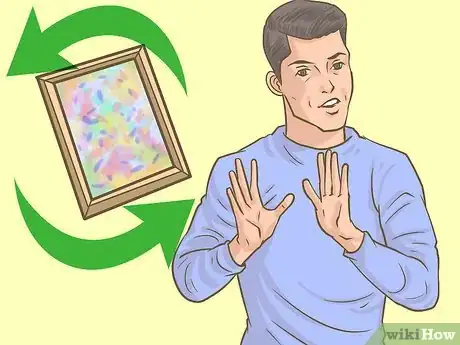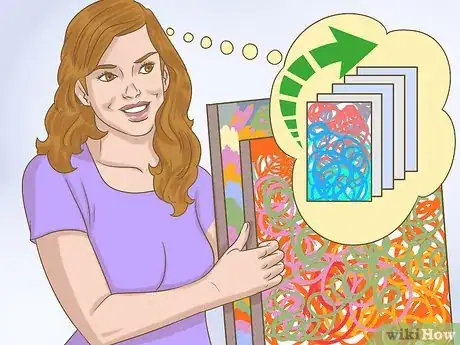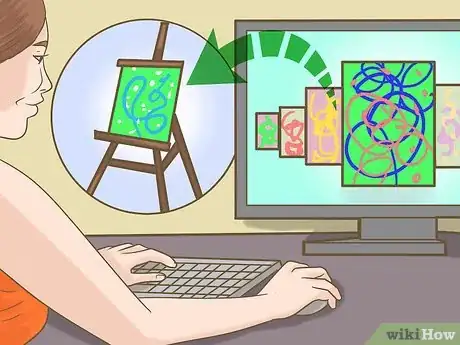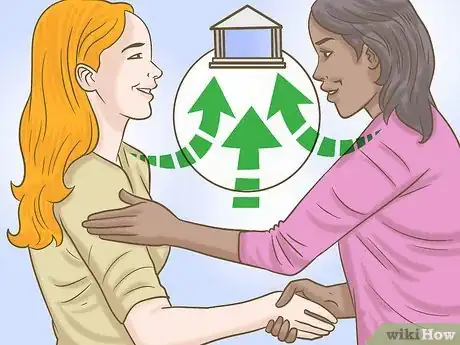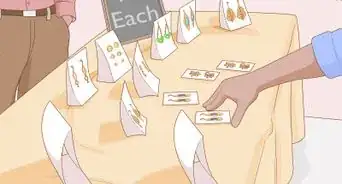This article was co-authored by Natasha Dikareva, MFA. Natasha Dikareva is a San Francisco, California based sculptor, and installation artist. With over 25 years of ceramics, sculpting, and installation experience, Natasha also teaches a ceramic sculpture workshop titled "Adventures in Clay" covering concept development, hand-building techniques, texture, and glazing techniques. Her work has been featured in solo and group exhibitions at the Beatrice Wood Center for the Arts, Abrams Claghorn Gallery, Bloomington Center for the Arts, Maria Kravetz Gallery, and the American Museum of Ceramic Art. She has taught at the University of Minnesota and the American Indian OIC School. She has been awarded the Excellence Award at the 1st World Teapot Competition, Best in Show at the 4th Clay & Glass Biennial Competition, and a Grand Prize at the American Museum of Ceramic Art. Natasha holds an MFA from the University of Minnesota and a BFA from Kiev Fine Arts College.
There are 7 references cited in this article, which can be found at the bottom of the page.
This article has been viewed 207,237 times.
The art world can be difficult to break into, due to the competition for limited spaces in gallery shows. Getting into a gallery is a great step toward selling your art and feeling more serious as an artist. Competition is fierce, but if you are able to make your work stand out and generate attention, you can get your art into the gallery of your dreams.
Steps
Submitting Your Art to a Gallery
-
1Check gallery websites for submission policies. It is best not to approach a gallery about submitting your work until you learn their policies. If you can’t find the information online, call them to inquire about submission, or ask in person. Follow the guidelines closely to demonstrate that you respect their rules.
- Some galleries do not accept submissions. If this is the case, look for connections that you might have to artists who have been in the gallery, and ask them to refer you to the curator. This might be your only option for getting into more prestigious galleries.
-
2Email a "letter of inquiry" to the galleries of interest to you. Include illustrious examples of your work, a description of your artistic approach, and a link to your artist website. Focus on what you can offer to the gallery, rather than what they can offer you. Many curators like to collect paper documents on artists before they will show their work.
- Include high-quality images of your work as attachments to the email. If they’re interested, they’ll look through your work and have a copy of it on hand.
Advertisement -
3Secure a referral from a respected member of the art world. One of the best and easiest ways to get your foot in the door at a gallery is by having a referral from someone who has a connection with the curator. This can be an artist who has shown there before, an art critic in the field, or a respected buyer. If you don’t already have a connection, make one by contacting them.[1]
- Always be respectful of the people who you are asking for a referral, and be understanding if they don’t feel like they can offer you one at this time. Ask if there’s anything that you can do better. They might be able to steer you in a new direction with your work!
-
4Practice talking about your art. Often, you’ll have to sell yourself and your work to a curator in order to get them interested. Practice your elevator pitch and decide on 3 specific points that make your art exciting and worth the gallery’s attention.
- For example, if you’re a painter, you could say “I work with oil on canvas to create representative images of the contemporary, middle-class version of the American Dream. I like to focus on the imagery of capitalism and overabundance.”
-
5Explain how your art fits into the pieces already in the gallery. Mention a time that you visited a show at the gallery and saw pieces that had a common theme with your work. Talk about specific pieces that are currently in the gallery and how they pair well with your work. This can be through color, medium, artist background, or theme.[2]
- If you have a connection with or were inspired by one of the artists who has been featured in the gallery before or is being shown there, mention that to the curator.
-
6Be specific about what makes your art special. It’s important to emphasize that your art stands out from the crowd, because galleries are often inundated with submissions. Explain what you’re doing differently, and identify how your art fits into a common theme. Emphasize that it stands out due to the craftsmanship, quality of work, perspective, or experience of viewing.[3]
- However, make sure you do your research before claiming that your art style is completely unique or one of a kind. A curator will know their art in and out, so making an unsubstantiated claim like that can hurt you.
- If your medium isn’t completely unique or you’re participating in a more traditional form of art, explain to the curator how your take on this classic medium is different, modern, and refreshing.
-
7Organize your work into categories or groups. Make sure your groupings, series, or categories are easily understandable. Include details about the work’s theme, how the pieces fit together, how many pieces will ultimately be in the group, and when you expect to be finished.[4]
- For example, you can say “These are the first 5 pieces of my Intergalactic Pioneers Series. All 15 of the pieces will be completed within the year, and will showcase the faces of the future of space travel, including portraits of both real-world figures from NASA, SpaceX, and the ISS, as well as imaginary creatures from afar.”
-
8Create some context for your art. Show the curator how your art fits together in a sort of story or narrative of your life or the life of your subjects. When you present your work to them, have it organized in a purposeful and thoughtful manner that conveys your intended message.[5]
- For example, if you have a set of sculptures that are all related in the subject, you might present them in the order that you made them because they are intended to be viewed as a series.
- If you have a set of paintings that have a similar theme, be comfortable with connecting the similarities of the paintings to one another.
-
9Evaluate what rate of commission you are comfortable with. If the gallery is interested in your work, they will inform you of their interest. Galleries make money off of the commission of the sale of art. Normally, this can range from 30-60% of the total amount paid for the piece by a collector. Have a percentage in mind, based on the listed value of your art, that you would feel comfortable accepting.
- Keep in mind they are offering you a space to exhibit and sell your work that you would not have otherwise had.
-
10Sign with a gallery. The gallery will present you with a contract for including your art in their space. Be clear with what you desire, but remember that they are the business owners. Ensure the commission percentage is clearly specified in the contract. [6]
- Thoroughly read any contract you sign, as it may stipulate that you may show and sell work exclusively through that gallery.
Visiting Galleries and Gaining Exposure
-
1Visit galleries near you. Many galleries are run by curators with specific tastes and a vision for their space. Take a look around each gallery and identify what connects all of the pieces. Speak to the curator if they are present, and ask them what kind of pieces they are looking to add to their collection.
- Developing a positive relationship with the curator and becoming part of the gallery community is a great way to get yourself on their radar, even if your work might not fit their specific gallery. You never know who they might know!
-
2Go to openings and network. Openings are normally on a set night every week. View and appreciate the art, but sell your own enthusiasm and skill. Approach artists, curators, and spectators to discuss the art being shown and your own art.[7]
- Have your elevator pitch in mind! Keep the discussion of your art short, especially if they don’t seem interested in discussing it. Remember you’re at someone else’s gallery and viewing someone else’s work.
-
3Apply for grants. Grants provide funding for artists to continue working on projects that fit a certain theme. When you apply for grants, you expose yourself to artists and curators who are on judging panels. This will establish you as an artist who takes your work seriously.[8]
-
4Avoid shows that require an entry fee. These "competitions" are usually fundraisers for the organization or gallery and offer very little in terms of career advancement. It is best to save your money and avoid paying fees to be involved in a show or gallery exhibition. Legitimate galleries make money off of the sale of the art, rather than entrance fees from artists.[9]
-
5Create an online gallery website. Having an online presence for your work is extremely important. You can invite other local artists, or other artists with similar styles, to showcase art on a website in a digital gallery. Make sure to include the professional contact information of each artist on the website.[10]
- Include only high-quality digital images of your artwork. Once you have digital images of your work, create a website and get a professional email address.
-
6Join an artist collective gallery. These galleries normally don't take a cut of your work but require monthly membership fees. Membership will allow you to make many connections and participate in a larger body of work with other artists over a long period of time. You might also have access to group resources and a space to work.[11]
- Becoming a member can be very competitive, so you will likely still need to present your work and artist statement for acceptance.
Outreach Help
Expert Q&A
-
QuestionHow do I get my art noticed?
 Natasha Dikareva, MFANatasha Dikareva is a San Francisco, California based sculptor, and installation artist. With over 25 years of ceramics, sculpting, and installation experience, Natasha also teaches a ceramic sculpture workshop titled "Adventures in Clay" covering concept development, hand-building techniques, texture, and glazing techniques. Her work has been featured in solo and group exhibitions at the Beatrice Wood Center for the Arts, Abrams Claghorn Gallery, Bloomington Center for the Arts, Maria Kravetz Gallery, and the American Museum of Ceramic Art. She has taught at the University of Minnesota and the American Indian OIC School. She has been awarded the Excellence Award at the 1st World Teapot Competition, Best in Show at the 4th Clay & Glass Biennial Competition, and a Grand Prize at the American Museum of Ceramic Art. Natasha holds an MFA from the University of Minnesota and a BFA from Kiev Fine Arts College.
Natasha Dikareva, MFANatasha Dikareva is a San Francisco, California based sculptor, and installation artist. With over 25 years of ceramics, sculpting, and installation experience, Natasha also teaches a ceramic sculpture workshop titled "Adventures in Clay" covering concept development, hand-building techniques, texture, and glazing techniques. Her work has been featured in solo and group exhibitions at the Beatrice Wood Center for the Arts, Abrams Claghorn Gallery, Bloomington Center for the Arts, Maria Kravetz Gallery, and the American Museum of Ceramic Art. She has taught at the University of Minnesota and the American Indian OIC School. She has been awarded the Excellence Award at the 1st World Teapot Competition, Best in Show at the 4th Clay & Glass Biennial Competition, and a Grand Prize at the American Museum of Ceramic Art. Natasha holds an MFA from the University of Minnesota and a BFA from Kiev Fine Arts College.
Ceramics & Sculpting Instructor Try networking with potential buyers. The more you make a personal connection with people, the more they'll be interested in your artwork. It's also helpful to promote your artwork on social media.
Try networking with potential buyers. The more you make a personal connection with people, the more they'll be interested in your artwork. It's also helpful to promote your artwork on social media. -
QuestionHow much should I charge for my artwork at a gallery?
 Natasha Dikareva, MFANatasha Dikareva is a San Francisco, California based sculptor, and installation artist. With over 25 years of ceramics, sculpting, and installation experience, Natasha also teaches a ceramic sculpture workshop titled "Adventures in Clay" covering concept development, hand-building techniques, texture, and glazing techniques. Her work has been featured in solo and group exhibitions at the Beatrice Wood Center for the Arts, Abrams Claghorn Gallery, Bloomington Center for the Arts, Maria Kravetz Gallery, and the American Museum of Ceramic Art. She has taught at the University of Minnesota and the American Indian OIC School. She has been awarded the Excellence Award at the 1st World Teapot Competition, Best in Show at the 4th Clay & Glass Biennial Competition, and a Grand Prize at the American Museum of Ceramic Art. Natasha holds an MFA from the University of Minnesota and a BFA from Kiev Fine Arts College.
Natasha Dikareva, MFANatasha Dikareva is a San Francisco, California based sculptor, and installation artist. With over 25 years of ceramics, sculpting, and installation experience, Natasha also teaches a ceramic sculpture workshop titled "Adventures in Clay" covering concept development, hand-building techniques, texture, and glazing techniques. Her work has been featured in solo and group exhibitions at the Beatrice Wood Center for the Arts, Abrams Claghorn Gallery, Bloomington Center for the Arts, Maria Kravetz Gallery, and the American Museum of Ceramic Art. She has taught at the University of Minnesota and the American Indian OIC School. She has been awarded the Excellence Award at the 1st World Teapot Competition, Best in Show at the 4th Clay & Glass Biennial Competition, and a Grand Prize at the American Museum of Ceramic Art. Natasha holds an MFA from the University of Minnesota and a BFA from Kiev Fine Arts College.
Ceramics & Sculpting Instructor Look around at what other similar artists are charging to get a better idea of what's a fair price. If you're a beginner, it's a good idea to set your prices low at first. You can raise them as you start to sell more work.
Look around at what other similar artists are charging to get a better idea of what's a fair price. If you're a beginner, it's a good idea to set your prices low at first. You can raise them as you start to sell more work. -
QuestionHow good do my paintings have to be?
 Community AnswerIn order to get into a gallery, they have to be technically and artistically very good. However, what determines that varies dependent on the art, the gallery, the local artistic culture and so forth. Get independent advice from a range of people as to what they think about your artwork.
Community AnswerIn order to get into a gallery, they have to be technically and artistically very good. However, what determines that varies dependent on the art, the gallery, the local artistic culture and so forth. Get independent advice from a range of people as to what they think about your artwork.
Warnings
- Be prepared for rejection. Everyone gets turned down. Keep trying.⧼thumbs_response⧽
- Watch your budget. Spend as little as possible, but try to maintain a high degree of professionalism.⧼thumbs_response⧽
References
- ↑ http://faso.com/fineartviews/2159/12-steps-to-get-your-artwork-noticed-by-galleries
- ↑ http://www.artbusiness.com/artists-how-to-get-your-art-into-galleries.html
- ↑ http://www.artbusiness.com/artists-how-to-get-your-art-into-galleries.html
- ↑ http://www.artbusiness.com/artists-how-to-get-your-art-into-galleries.html
- ↑ http://www.artbusiness.com/artists-how-to-get-your-art-into-galleries.html
- ↑ http://www.artbusiness.com/artists-how-to-get-your-art-into-galleries.html
- ↑ https://www.artworkarchive.com/blog/7-helpful-networking-tips-for-artists
- ↑ http://www.artbusiness.com/osorgrants.html
- ↑ http://www.spacial-anomaly.com/why-artists-should-avoid-vanity-galleries/
About This Article
To get your art in a gallery, start by checking the gallery website for submission policies. You can also call the gallery or email a letter of inquiry, including illustrations of your work, a description of your artistic approach, and a link to your artist website. As you prepare to speak with the curator, think about 3 specific points that make your art exciting and worth the gallery’s attention as well as how your art fits with the pieces already in the gallery. To learn how to network at gallery openings, keep reading!





